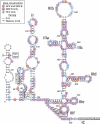Characterization of a canine homolog of hepatitis C virus
- PMID: 21610165
- PMCID: PMC3136326
- DOI: 10.1073/pnas.1101794108
Characterization of a canine homolog of hepatitis C virus
Abstract
An estimated 3% of the world's population is chronically infected with hepatitis C virus (HCV). Although HCV was discovered more than 20 y ago, its origin remains obscure largely because no closely related animal virus homolog has been identified; furthermore, efforts to understand HCV pathogenesis have been hampered by the absence of animal models other than chimpanzees for human disease. Here we report the identification in domestic dogs of a nonprimate hepacivirus. Comparative phylogenetic analysis of the canine hepacivirus (CHV) confirmed it to be the most genetically similar animal virus homolog of HCV. Bayesian Markov chains Monte Carlo and associated time to most recent common ancestor analyses suggest a mean recent divergence time of CHV and HCV clades within the past 500-1,000 y, well after the domestication of canines. The discovery of CHV may provide new insights into the origin and evolution of HCV and a tractable model system with which to probe the pathogenesis, prevention, and treatment of diseases caused by hepacivirus infection.
Conflict of interest statement
The authors declare no conflict of interest.
Figures




Comment in
-
Hepatitis C homolog in dogs with respiratory illness.Proc Natl Acad Sci U S A. 2011 Aug 2;108(31):12563-4. doi: 10.1073/pnas.1107612108. Epub 2011 Jul 18. Proc Natl Acad Sci U S A. 2011. PMID: 21768355 Free PMC article. No abstract available.
References
-
- Parrish CR, Kawaoka Y. The origins of new pandemic viruses: The acquisition of new host ranges by canine parvovirus and influenza A viruses. Annu Rev Microbiol. 2005;59:553–586. - PubMed
-
- Tsai CC, et al. Prevention of SIV infection in macaques by (R)-9-(2-phosphonylmethoxypropyl)adenine. Science. 1995;270:1197–1199. - PubMed
-
- Van Rompay KK. Evaluation of antiretrovirals in animal models of HIV infection. Antiviral Res. 2010;85:159–175. - PubMed
Publication types
MeSH terms
Substances
Associated data
- Actions
- Actions
Grants and funding
- R01 AI072613/AI/NIAID NIH HHS/United States
- AI090055/AI/NIAID NIH HHS/United States
- AI070411/AI/NIAID NIH HHS/United States
- U01 AI070411/AI/NIAID NIH HHS/United States
- R24 EY017404/EY/NEI NIH HHS/United States
- R01 AI090055/AI/NIAID NIH HHS/United States
- U54 AI057158/AI/NIAID NIH HHS/United States
- AI072613/AI/NIAID NIH HHS/United States
- EY017404/EY/NEI NIH HHS/United States
- R21 AI090196/AI/NIAID NIH HHS/United States
- R01 AI079231/AI/NIAID NIH HHS/United States
- AI57158/AI/NIAID NIH HHS/United States
- AI079231/AI/NIAID NIH HHS/United States
- AI090196/AI/NIAID NIH HHS/United States
LinkOut - more resources
Full Text Sources
Other Literature Sources
Molecular Biology Databases
Miscellaneous

